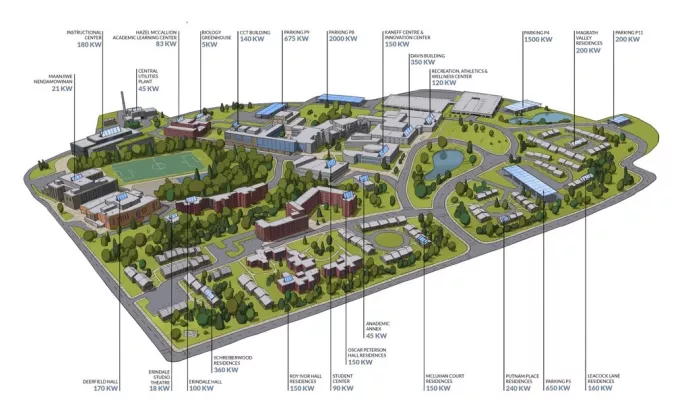In 2020, UTM completed a Utilities Master Plan to enhance our utilities infrastructure operating efficiency, redundancy and resiliency to meet anticipated future campus growth.
The Utilities Master Plan recommended a nodal plant approach, where two new nodal utilities plants are to be constructed with optional future interconnections with the existing Central Utilities Plant (CUP1).
The first new nodal plant (CUP2) will be integrated within the new F2 Building (currently in design) located on the west side of the campus and to be constructed in the next five years. The second new nodal plant (CUP3) will be integrated within the new Athletics & Parking Expansion Building on the east side of the campus to be constructed in the next 10-15 years (CUP3).
Our new buildings will utilize nodal plants, with centralized electrical infrastructure, and a district ground-source heat pump system with geo-exchange borefields to meet connected buildings’ thermal and electrical needs. As an innovative institution, UTM is continually looking at renewable technology to support its ambitious long-term goals.
To date, the university has investigated renewable natural gas, wind generation, wastewater heat recovery systems and solar power. Detailed feasibility studies have been performed on these technologies to determine viability, cost, and associated GHG reduction potential. In the next several years, as these technologies become more financially feasible, we will implement these projects to realize our climate positive goals.
Expanding Solar Power on Campus
Harnessing solar power will enable us to reduce the use of electricity from the grid, and gas-heated hot water. We have plans to retrofit feasible existing rooftops with solar panels, in addition to our on-going minimum commitment of 5 per cent renewable energy generation on all new capital projects as part of our new energy performance design standard.
The photo below showcases anticipated solar expansion on our campus rooftops and parking lots over the next 27 years. Installing solar pv, and investigating other renewable technologies will help us to meet our 2050 climate positive goal.

